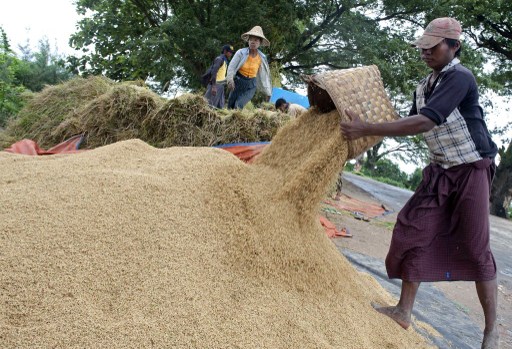INMA VILLAGE, Irrawaddy Division — Until a few years ago, Hla Myint mostly relied on manure to fertilise his 30-acre paddy farm in Inma village, but he switched to chemical fertiliser after he was forced to sell his cattle to raise money.
These days, he spends about $1,800 per growing season on 3,000 kilograms of fertiliser, without which, Hla Myint estimates, his fields in Pantanaw Township would produce 6,000 kilograms less paddy.
“Despite depletion of the soil, I can maintain good paddy production by using plenty of fertiliser,” he says.
In Irrawaddy Division, Burma’s main rice-growing region, farmers have long grown paddy with relatively little chemical fertiliser, capital and machinery when compared to their Asian peers. Their yields are among the region’s lowest, as are paddy prices.
In recent years, farmers like Hla Myint have come under pressure to modernise, as labour costs rise and productivity of the delta’s soil declines. Most are now increasing fertiliser use to boost their yields and raise incomes.
Many farmers, however, lack capital to afford much fertiliser, while few have adequate knowledge to make an informed choice of products on the market, which is poorly regulated and includes a range of foreign and local fertilisers.
Substandard brands
Myo Chit, chairman of the Irrawaddy Division Farmers Union, said the unreliable quality of fertiliser was a problem for farmers, adding that the union wants “the government to carry out systematic examination of the quality of fertilisers.”
Irrawaddy Division Minister for Agriculture, Livestock and Natural Resources Ba Hein said sale of below-par fertiliser brands was common, though the exact scale of the problem remains unclear, while some seeds and pesticide brands were also suspect.
Htay Win, a deputy director at the division’s Agricultural Department, said officials conduct bi-weekly checks among 779 registered fertiliser distributors in the delta and laboratory test some brands.
In February, authorities banned three local fertiliser brands, including Shwe Naga Top One of Universe Industrial Group Co. Ltd. The brands contained one type of nutrient, namely nitrogen, but were registered as a mixed fertiliser.
Farmer Hla Myint said Shwe Naga Top One had been the most popular fertiliser among local farmers, who were now unsure of which fertilisers they can trust.
“The farmers have little knowledge about chemical fertilisers. We just choose the ones that have interesting-looking brands. After Shwe Naga was banned, the farmers turned to another fertiliser that included weedkillers,” he said.
A 2016 study of the World Bank and the Livelihoods and Food Security Trust Fund (LIFT) found that Burmese farmers’ fertiliser use was “often at inefficient application rates and inappropriate nutrient composition,” a problem caused by a lack of agricultural research and public education by the government.
The study noted that fertiliser use in Irrawaddy Division is limited as paddy prices are relatively low and fertiliser prices high.
Myint Lwin, a former director at the division’s Agricultural Department, said officials were aware of “the very high price of fertiliser domestically compared with international prices, but … the government cannot interfere in the market.”
Burma’s farmers, meanwhile, have little access to capital; at best they can receive an annual government loan of $125 per acre.
Farmer Soe Thiha said his yields had increased by around 20 percent after he started using about 250 kilograms of fertiliser on his 5-acre paddy farm in Kyaunggone village in recent years.
“I’m considering how to further increase my harvest, though I don’t know the advantages and disadvantages of the different fertilisers,” he said.
Ohnmar Khing, an agriculture expert at the Rangoon office of the Australia Agricultural Research Department, said the rapid rise in fertiliser use is understandable as Burmese farmers need to increase production, but she warned that intensive fertiliser use could be harmful.
“We need to reduce chemical fertiliser if we want to have sustainable development that is the least damaging for humans and environment,” she said.
Htay Win, the agricultural official, said farmers often struggle to choose the right mix of fertilisers containing nutrients such as nitrogen, phosphate and potassium.
In 15 of the 26 townships in Irrawaddy Division farmers face soil depletion, she said, citing records of the past four years, a situation that can be addressed by choosing the best mix of fertilisers and proper ploughing of the fertiliser into the soil.
Htay Win said to help farmers with such issues her department had carried out public education programmes on nitrogen fertiliser in 1955 villages in 26 townships this year.
Thein Aung, chairman of the Freedom Peasants Association Myanmar, said, however, that such government programmes reached few farmers and did little to address the problems.
“Education programmes by officials are not effective,” he said. “I have never heard of any training programmes on how to use fertilisers, pesticides or other agricultural methods.”
This story originally appeared on Myanmar Now.



